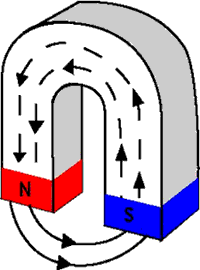Magnetic Field Characteristics
After reading this section you will be able to do the following:
- Describe magnetic fields in different shaped magnets.
- Understand the important properties possessed by magnetic lines of force.
Magnetic Field In and Around a Bar Magnet
As discussed previously, a magnetic field is a change in energy within a volume of space. The magnetic field surrounding a bar magnet can be seen in the magnetograph below. A magnetograph can be created by placing a piece of paper over a magnet and sprinkling the paper with iron filings. The particles align themselves with the lines of magnetic force produced by the magnet. The magnetic lines of force show where the magnetic field exits the material at one pole and reenters the material at another pole along the length of the magnet. It should be noted that the magnetic lines of force exist in three dimensions but are only seen in two dimensions in the image.

It can be seen in the magnetograph that there are poles all along the length of the magnet but that the poles are concentrated at the ends of the magnet. The area where the exit poles are concentrated is called the magnet's north pole and the area where the entrance poles are concentrated is called the magnet's south pole.
Magnetic Fields in and around Horseshoe and Ring Magnets
 Magnets come in a variety of shapes and one of the more common is the horseshoe (U) magnet. The horseshoe magnet has north and south poles just like a bar magnet but the magnet is curved so the poles lie in the same plane. The magnetic lines of force flow from pole to pole just like in the bar magnet. However, since the poles are located closer together and a more direct path exists for the lines of flux to travel between the poles, the magnetic field is concentrated between the poles.
Magnets come in a variety of shapes and one of the more common is the horseshoe (U) magnet. The horseshoe magnet has north and south poles just like a bar magnet but the magnet is curved so the poles lie in the same plane. The magnetic lines of force flow from pole to pole just like in the bar magnet. However, since the poles are located closer together and a more direct path exists for the lines of flux to travel between the poles, the magnetic field is concentrated between the poles.
 If a bar magnet was placed across the end of a horseshoe magnet or if a magnet was formed in the shape of a ring, the lines of magnetic force would not even need to enter the air. The value of such a magnet where the magnetic field is completely contained with the material probably has limited use. However, it is important to understand that the magnetic field can flow in loop within a material. (See section on circular magnetism for more information).
If a bar magnet was placed across the end of a horseshoe magnet or if a magnet was formed in the shape of a ring, the lines of magnetic force would not even need to enter the air. The value of such a magnet where the magnetic field is completely contained with the material probably has limited use. However, it is important to understand that the magnetic field can flow in loop within a material. (See section on circular magnetism for more information).
General Properties of Magnetic Lines of Force
Magnetic lines of force have a number of important properties, which include: .jpg)
- They seek the path of least resistance between opposite magnetic poles. In a single bar magnet as shown to the right, they attempt to form closed loops from pole to pole.
- They never cross one another.
- They all have the same strength.
- Their density decreases (they spread out) when they move from an area of higher permeability to an area of lower permeability.
- Their density decreases with increasing distance from the poles.
- They are considered to have direction as if flowing, though no actual movement occurs.
- They flow from the south pole to the north pole within a material and north pole to south pole in air.
Review:
- Magnetic lines of force exist in three dimensions but are only seen in two dimensions in typical depictions.
- Magnets come in a variety of shapes and one of the more common is the horseshoe (U) magnet.
- Magnetic field lines never cross one another.